Abstract
Crohn's disease represents part of a spectrum of inflammatory bowel diseases characterized by immune regulatory defects and genetic predisposition. T cell antigen receptor V gene usage by T lymphocytes was investigated using four MAbs specific for various V gene products. One MAb (Ti3a), reactive with V beta 8 gene products, detected increased numbers of T cells in a subset of Crohn's disease patients as compared with normal controls and ulcerative colitis patients. In family studies there was no apparent inherited predisposition to the use of V beta 8 genes, and there was no association between a restriction fragment length polymorphism of the V beta 8.1 gene and Crohn's disease. The V beta 8+ T cells were concentrated in the mesenteric lymph nodes draining the inflammatory lesions and belonged to both the CD4+ and CD8+ T cell subsets. In contrast, lamina propria and intraepithelial T cells were not enriched in V beta 8+ T cells, suggesting that these cells were participating in the afferent limb of a gut-associated immune response. The expanded V beta 8+ T cells in Crohn's disease appear to result from an immune response to an as yet unknown antigen.
Full text
PDF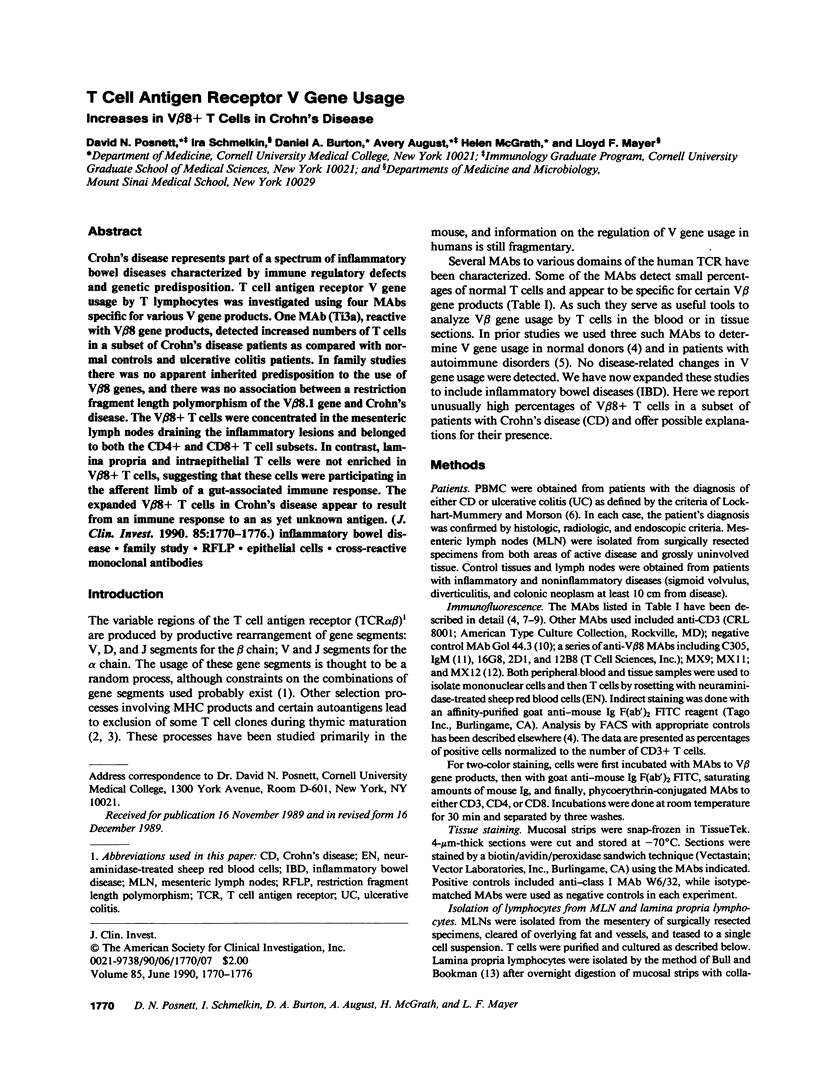
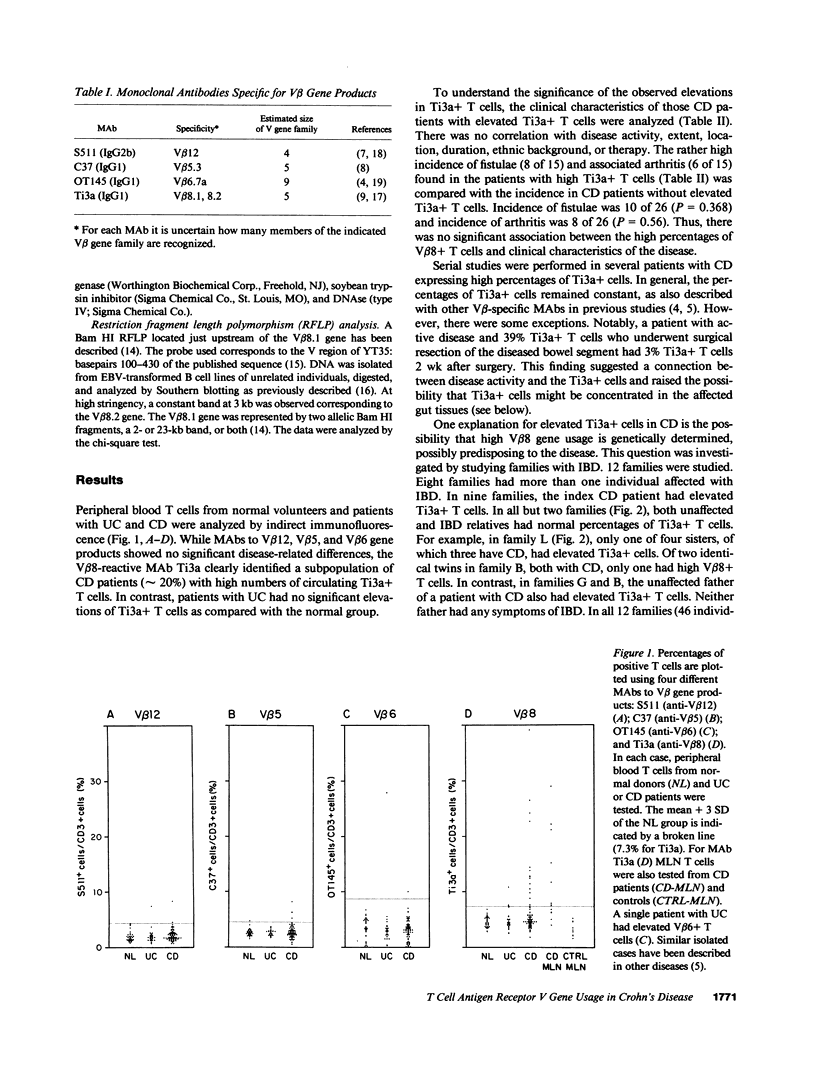
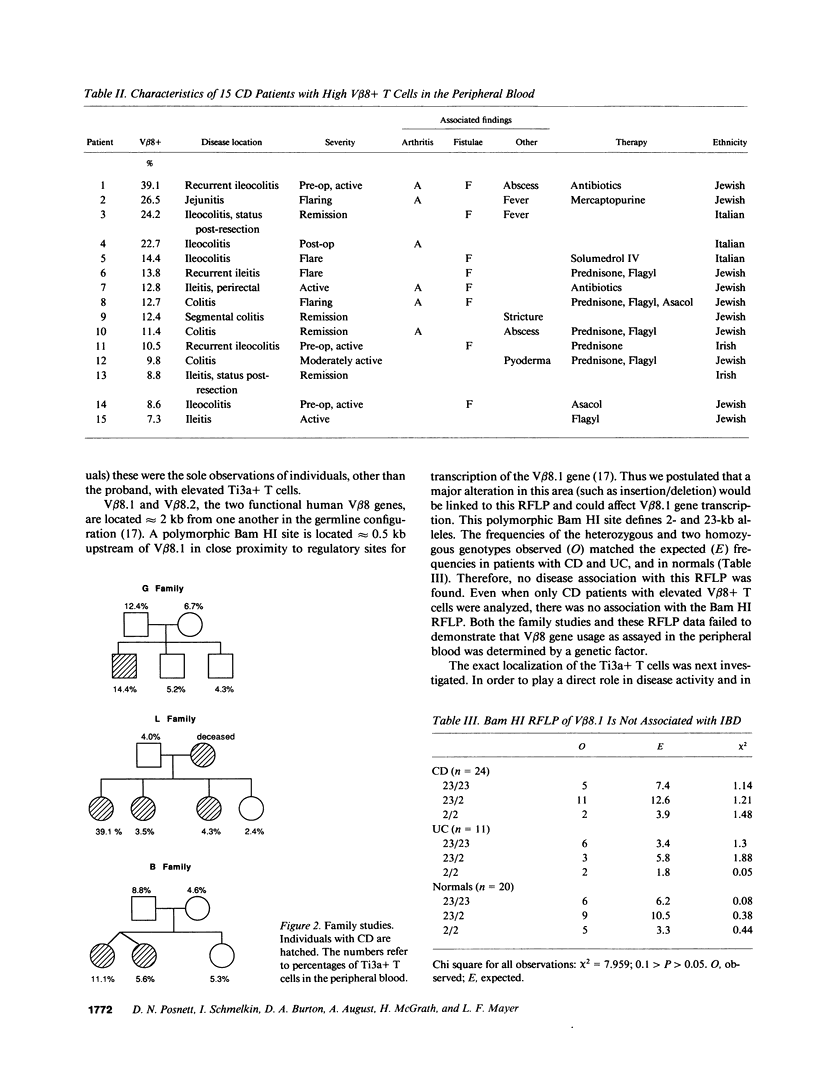
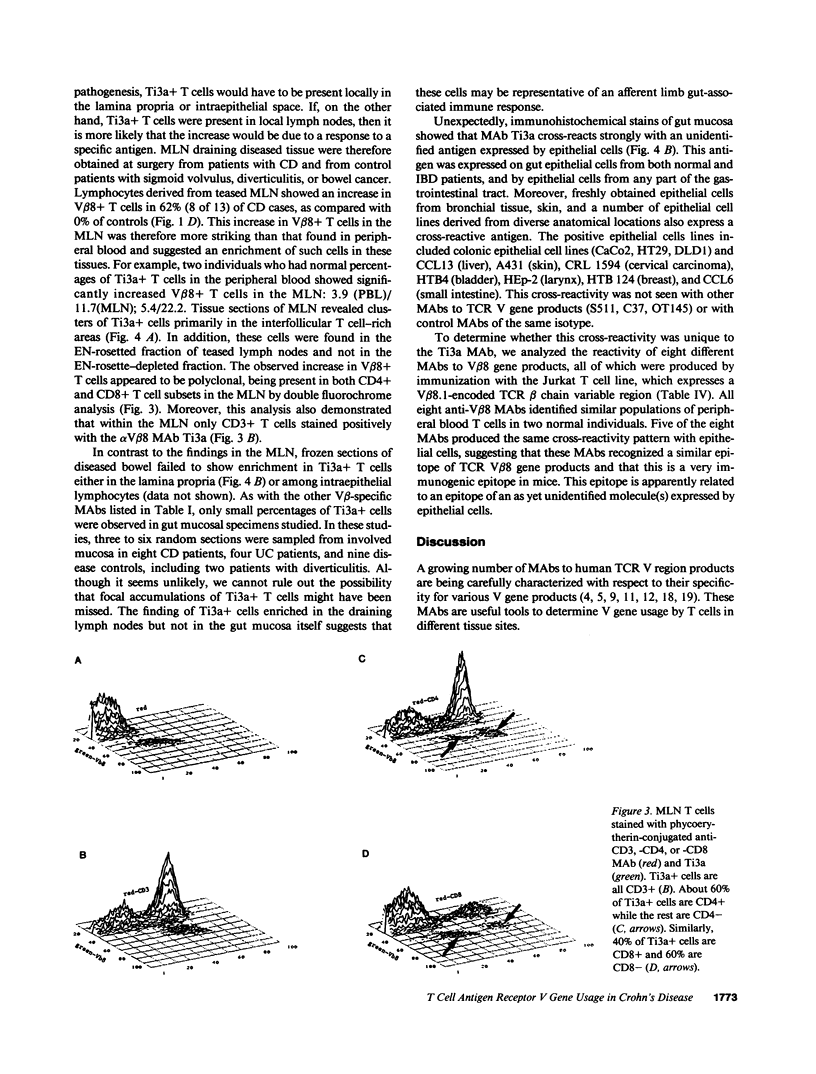
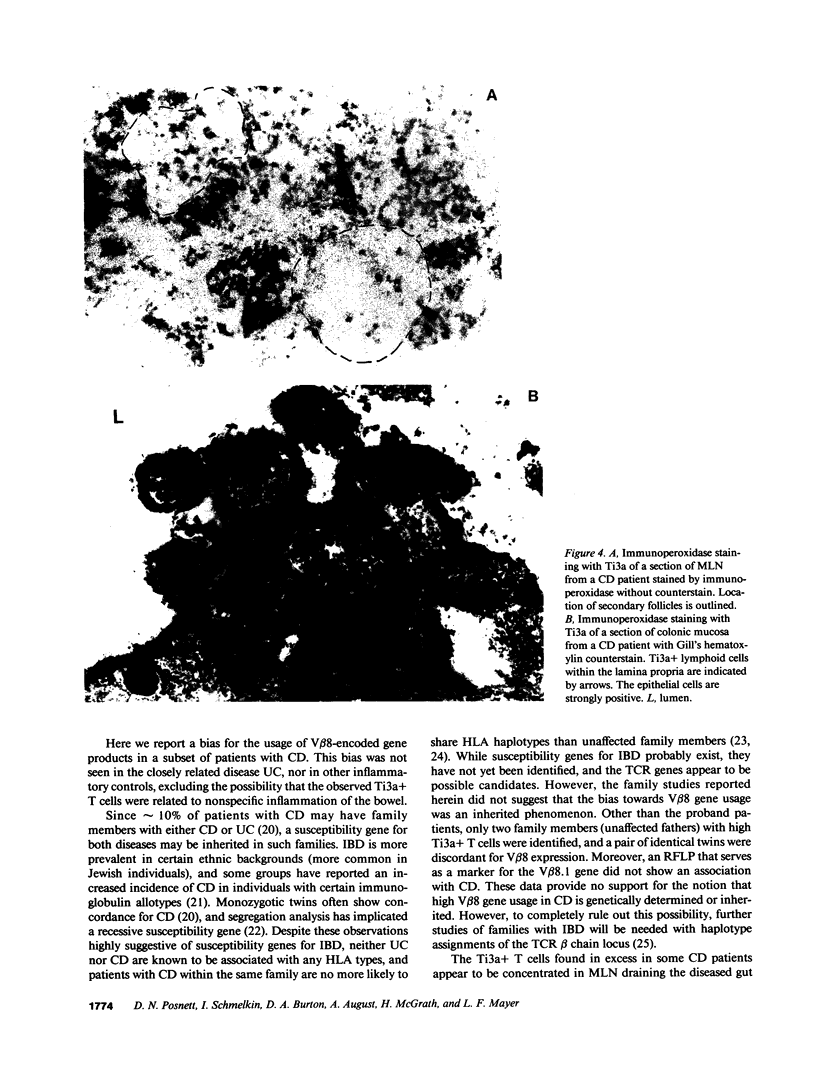
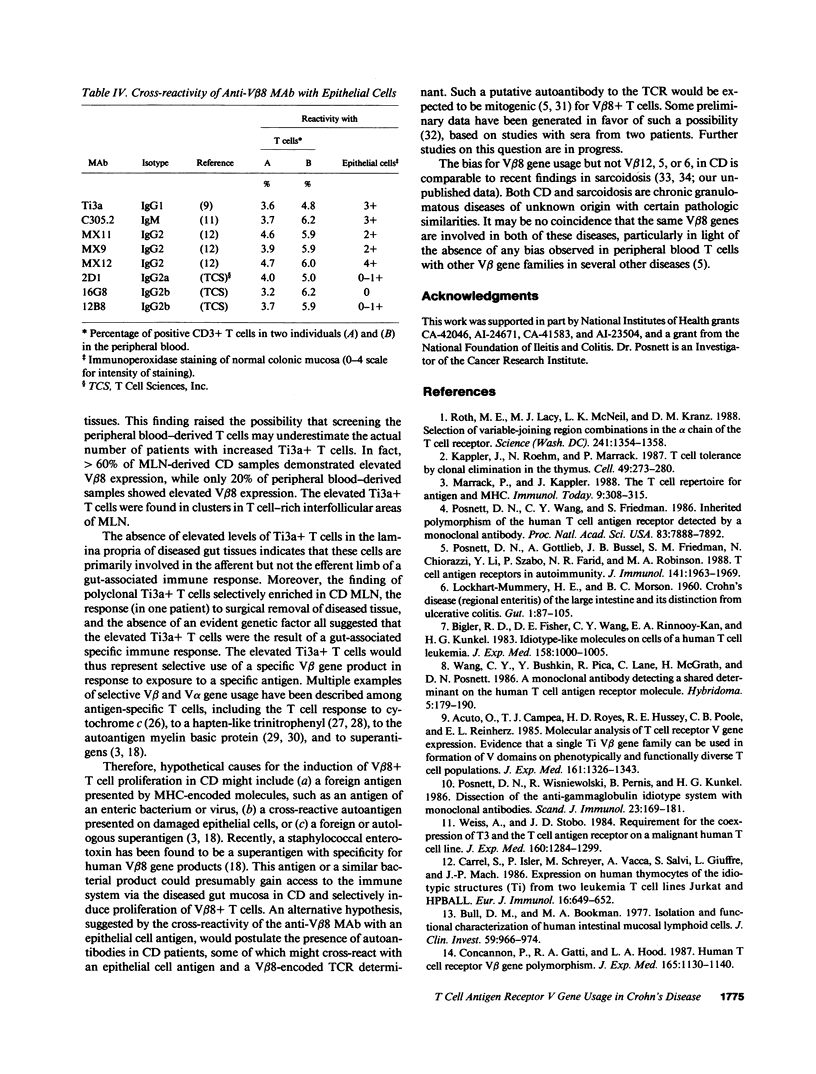
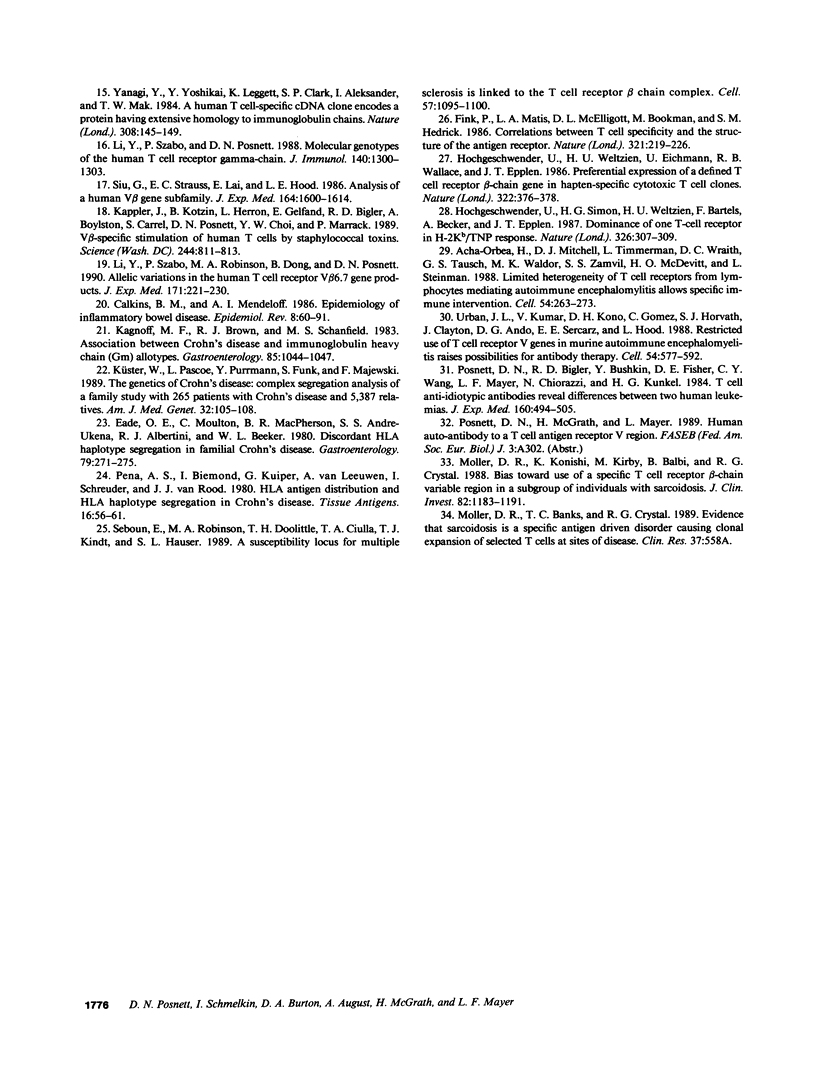
Images in this article
Selected References
These references are in PubMed. This may not be the complete list of references from this article.
- Acha-Orbea H., Mitchell D. J., Timmermann L., Wraith D. C., Tausch G. S., Waldor M. K., Zamvil S. S., McDevitt H. O., Steinman L. Limited heterogeneity of T cell receptors from lymphocytes mediating autoimmune encephalomyelitis allows specific immune intervention. Cell. 1988 Jul 15;54(2):263–273. doi: 10.1016/0092-8674(88)90558-2. [DOI] [PubMed] [Google Scholar]
- Acuto O., Campen T. J., Royer H. D., Hussey R. E., Poole C. B., Reinherz E. L. Molecular analysis of T cell receptor (Ti) variable region (V) gene expression. Evidence that a single Ti beta V gene family can be used in formation of V domains on phenotypically and functionally diverse T cell populations. J Exp Med. 1985 Jun 1;161(6):1326–1343. doi: 10.1084/jem.161.6.1326. [DOI] [PMC free article] [PubMed] [Google Scholar]
- Bigler R. D., Fisher D. E., Wang C. Y., Rinnooy Kan E. A., Kunkel H. G. Idiotype-like molecules on cells of a human T cell leukemia. J Exp Med. 1983 Sep 1;158(3):1000–1005. doi: 10.1084/jem.158.3.1000. [DOI] [PMC free article] [PubMed] [Google Scholar]
- Bull D. M., Bookman M. A. Isolation and functional characterization of human intestinal mucosal lymphoid cells. J Clin Invest. 1977 May;59(5):966–974. doi: 10.1172/JCI108719. [DOI] [PMC free article] [PubMed] [Google Scholar]
- Calkins B. M., Mendeloff A. I. Epidemiology of inflammatory bowel disease. Epidemiol Rev. 1986;8:60–91. doi: 10.1093/oxfordjournals.epirev.a036296. [DOI] [PubMed] [Google Scholar]
- Carrel S., Isler P., Schreyer M., Vacca A., Salvi S., Giuffre L., Mach J. P. Expression on human thymocytes of the idiotypic structures (Ti) from two leukemia T cell lines Jurkat and HPB-ALL. Eur J Immunol. 1986 Jun;16(6):649–652. doi: 10.1002/eji.1830160610. [DOI] [PubMed] [Google Scholar]
- Concannon P., Gatti R. A., Hood L. E. Human T cell receptor V beta gene polymorphism. J Exp Med. 1987 Apr 1;165(4):1130–1140. doi: 10.1084/jem.165.4.1130. [DOI] [PMC free article] [PubMed] [Google Scholar]
- Eade O. E., Moulton C., MacPherson B. R., Andre-Ukena S. S., Albertini R. J., Beeken W. L. Discordant HLA haplotype segregation in familial Crohn's disease. Gastroenterology. 1980 Aug;79(2):271–275. [PubMed] [Google Scholar]
- Fink P. J., Matis L. A., McElligott D. L., Bookman M., Hedrick S. M. Correlations between T-cell specificity and the structure of the antigen receptor. Nature. 1986 May 15;321(6067):219–226. doi: 10.1038/321219a0. [DOI] [PubMed] [Google Scholar]
- Hochgeschwender U., Simon H. G., Weltzien H. U., Bartels F., Becker A., Epplen J. T. Dominance of one T-cell receptor in the H-2Kb/TNP response. Nature. 1987 Mar 19;326(6110):307–309. doi: 10.1038/326307a0. [DOI] [PubMed] [Google Scholar]
- Hochgeschwender U., Weltzien H. U., Eichmann K., Wallace R. B., Epplen J. T. Preferential expression of a defined T-cell receptor beta-chain gene in hapten-specific cytotoxic T-cell clones. Nature. 1986 Jul 24;322(6077):376–378. doi: 10.1038/322376a0. [DOI] [PubMed] [Google Scholar]
- Kagnoff M. F., Brown R. J., Schanfield M. S. Association between Crohn's disease and immunoglobulin heavy chain (Gm) allotypes. Gastroenterology. 1983 Nov;85(5):1044–1047. [PubMed] [Google Scholar]
- Kappler J. W., Roehm N., Marrack P. T cell tolerance by clonal elimination in the thymus. Cell. 1987 Apr 24;49(2):273–280. doi: 10.1016/0092-8674(87)90568-x. [DOI] [PubMed] [Google Scholar]
- Kappler J., Kotzin B., Herron L., Gelfand E. W., Bigler R. D., Boylston A., Carrel S., Posnett D. N., Choi Y., Marrack P. V beta-specific stimulation of human T cells by staphylococcal toxins. Science. 1989 May 19;244(4906):811–813. doi: 10.1126/science.2524876. [DOI] [PubMed] [Google Scholar]
- Küster W., Pascoe L., Purrmann J., Funk S., Majewski F. The genetics of Crohn disease: complex segregation analysis of a family study with 265 patients with Crohn disease and 5,387 relatives. Am J Med Genet. 1989 Jan;32(1):105–108. doi: 10.1002/ajmg.1320320122. [DOI] [PubMed] [Google Scholar]
- LOCKHART-MUMMERY H. E., MORSON B. C. Crohn's disease (regional enteritis) of the large intestine and its distinction from ulcerative colitis. Gut. 1960 Jun;1:87–105. doi: 10.1136/gut.1.2.87. [DOI] [PMC free article] [PubMed] [Google Scholar]
- Li Y., Szabo P., Posnett D. N. Molecular genotypes of the human T cell receptor gamma-chain. J Immunol. 1988 Feb 15;140(4):1300–1303. [PubMed] [Google Scholar]
- Li Y., Szabo P., Robinson M. A., Dong B., Posnett D. N. Allelic variations in the human T cell receptor V beta 6.7 gene products. J Exp Med. 1990 Jan 1;171(1):221–230. doi: 10.1084/jem.171.1.221. [DOI] [PMC free article] [PubMed] [Google Scholar]
- Marrack P., Kappler J. The T-cell repertoire for antigen and MHC. Immunol Today. 1988 Oct;9(10):308–315. doi: 10.1016/0167-5699(88)91324-2. [DOI] [PubMed] [Google Scholar]
- Moller D. R., Konishi K., Kirby M., Balbi B., Crystal R. G. Bias toward use of a specific T cell receptor beta-chain variable region in a subgroup of individuals with sarcoidosis. J Clin Invest. 1988 Oct;82(4):1183–1191. doi: 10.1172/JCI113715. [DOI] [PMC free article] [PubMed] [Google Scholar]
- Peña A. S., Biemond I., Kuiper G., Weterman I. T., van Leeuwen A., Schreuder I., van Rood J. J. HLA antigen distribution and HLA haplotype segregation in Crohn's disease. Tissue Antigens. 1980 Jul;16(1):56–61. doi: 10.1111/j.1399-0039.1980.tb00287.x. [DOI] [PubMed] [Google Scholar]
- Posnett D. N., Bigler R. D., Bushkin Y., Fisher D. E., Wang C. Y., Mayer L. F., Chiorazzi N., Kunkel H. G. T cell antiidiotypic antibodies reveal differences between two human leukemias. J Exp Med. 1984 Aug 1;160(2):494–505. doi: 10.1084/jem.160.2.494. [DOI] [PMC free article] [PubMed] [Google Scholar]
- Posnett D. N., Gottlieb A., Bussel J. B., Friedman S. M., Chiorazzi N., Li Y., Szabo P., Farid N. R., Robinson M. A. T cell antigen receptors in autoimmunity. J Immunol. 1988 Sep 15;141(6):1963–1969. [PubMed] [Google Scholar]
- Posnett D. N., Wang C. Y., Friedman S. M. Inherited polymorphism of the human T-cell antigen receptor detected by a monoclonal antibody. Proc Natl Acad Sci U S A. 1986 Oct;83(20):7888–7892. doi: 10.1073/pnas.83.20.7888. [DOI] [PMC free article] [PubMed] [Google Scholar]
- Posnett D. N., Wisniewolski R., Pernis B., Kunkel H. G. Dissection of the human antigammaglobulin idiotype system with monoclonal antibodies. Scand J Immunol. 1986 Feb;23(2):169–181. doi: 10.1111/j.1365-3083.1986.tb01955.x. [DOI] [PubMed] [Google Scholar]
- Roth M. E., Lacy M. J., McNeil L. K., Kranz D. M. Selection of variable-joining region combinations in the alpha chain of the T cell receptor. Science. 1988 Sep 9;241(4871):1354–1358. doi: 10.1126/science.2970673. [DOI] [PubMed] [Google Scholar]
- Seboun E., Robinson M. A., Doolittle T. H., Ciulla T. A., Kindt T. J., Hauser S. L. A susceptibility locus for multiple sclerosis is linked to the T cell receptor beta chain complex. Cell. 1989 Jun 30;57(7):1095–1100. doi: 10.1016/0092-8674(89)90046-9. [DOI] [PubMed] [Google Scholar]
- Siu G., Strauss E. C., Lai E., Hood L. E. Analysis of a human V beta gene subfamily. J Exp Med. 1986 Nov 1;164(5):1600–1614. doi: 10.1084/jem.164.5.1600. [DOI] [PMC free article] [PubMed] [Google Scholar]
- Urban J. L., Kumar V., Kono D. H., Gomez C., Horvath S. J., Clayton J., Ando D. G., Sercarz E. E., Hood L. Restricted use of T cell receptor V genes in murine autoimmune encephalomyelitis raises possibilities for antibody therapy. Cell. 1988 Aug 12;54(4):577–592. doi: 10.1016/0092-8674(88)90079-7. [DOI] [PubMed] [Google Scholar]
- Wang C. Y., Bushkin Y., Pica R., Lane C., McGrath H., Posnett D. N. Stimulation and expansion of a human T-cell subpopulation by a monoclonal antibody to T-cell receptor molecule. Hybridoma. 1986 Fall;5(3):179–190. doi: 10.1089/hyb.1986.5.179. [DOI] [PubMed] [Google Scholar]
- Weiss A., Stobo J. D. Requirement for the coexpression of T3 and the T cell antigen receptor on a malignant human T cell line. J Exp Med. 1984 Nov 1;160(5):1284–1299. doi: 10.1084/jem.160.5.1284. [DOI] [PMC free article] [PubMed] [Google Scholar]
- Yanagi Y., Yoshikai Y., Leggett K., Clark S. P., Aleksander I., Mak T. W. A human T cell-specific cDNA clone encodes a protein having extensive homology to immunoglobulin chains. Nature. 1984 Mar 8;308(5955):145–149. doi: 10.1038/308145a0. [DOI] [PubMed] [Google Scholar]




